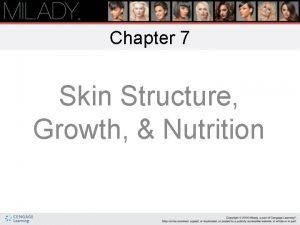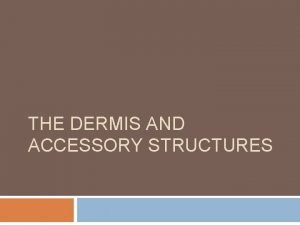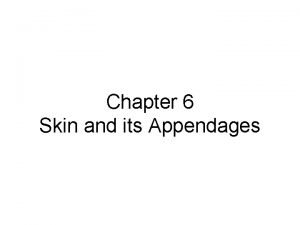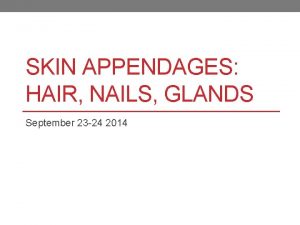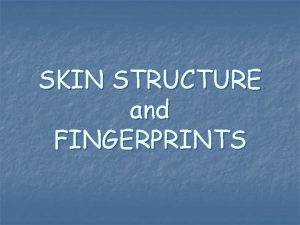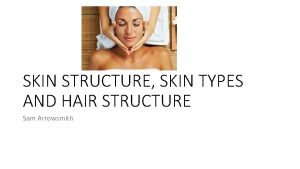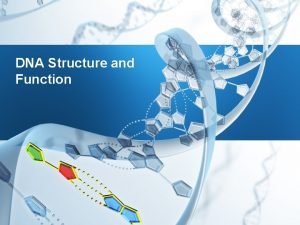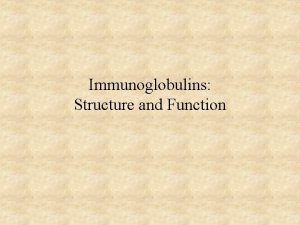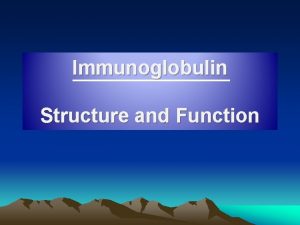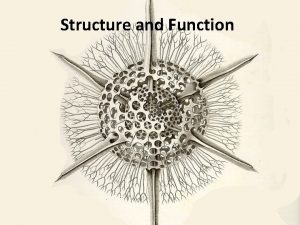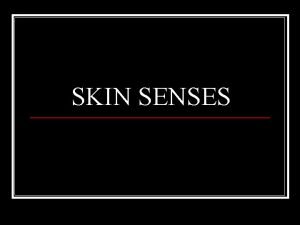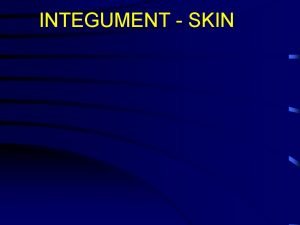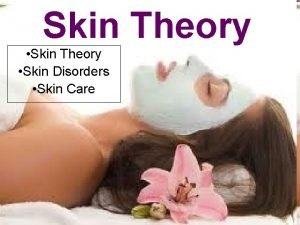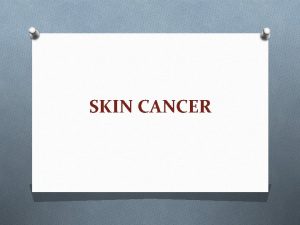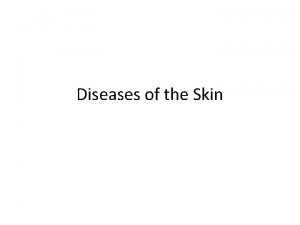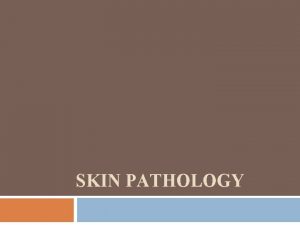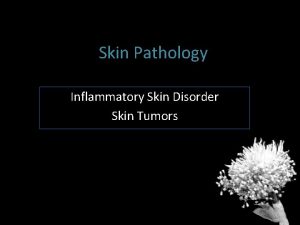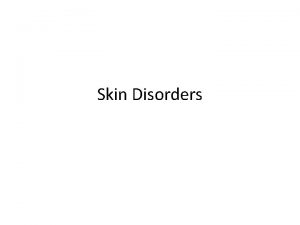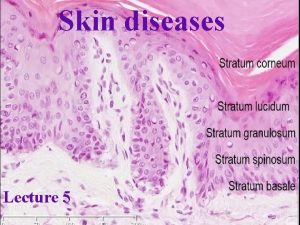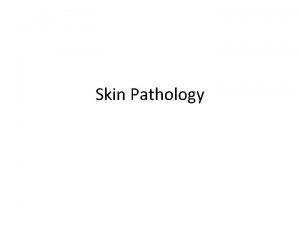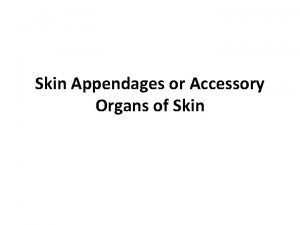STRUCTURE AND FUNCTION OF THE SKIN The skin




































- Slides: 36

STRUCTURE AND FUNCTION OF THE SKIN The skin – the interface between humans and their environment

Skin is your passport into the world

Skin can decide if you are : criminal innocent or

Skin can decide your race

Skin is the largest organ in the body

Skin weighs an average of

Skin covers an area of 2 m 2

It acts as a barrier, protecting the body from harsh external conditions and preventing the loss of important body constituents, especially water.


Epidermis • many layers of closely packed cells • the most superficial of which are flattened and filled with keratins; it is therefore a stratified squamous epithelium • The epidermis contains no blood vessels. • It varies in thickness from less than 0. 1 mm on the eyelids to nearly 1 mm on the palms and soles.

• Stem cells reside amongst interfollicular basal cells and amongst the cells of the external root sheath at the bulge in the hair follicle at the level of attachment of the arrector pili muscle.

• The basal layer, the deepest layer, rests on a basement membrane. • It is a single layer of columnar cells, whose basal surfaces sprout many fine processes and hemidesmosomes, anchoring them to lamina densa of basement membrane.

• The spinous or prickle cell layer is composed of keratinocytes. • These differentiating cells, which synthesize keratins, are larger than basal cells. • Keratinocytes are firmly attached to each other by small interlocking cytoplasmic processes, by abundant desmosomes and by other cadherins. • Under the light microscope, the desmosomes look like ‘prickles’.

• The granular layer, consists of two or three layers cells are flatter than those in the spinous layer, have more tonofibrils. • cells contain large irregular basophilic granules of keratohyalin, merge with tonofibrils. • keratohyalin granules break up and their contents are dispersed throughout the cytoplasm.

• The horny layer (stratum corneum) is made of piled-up layers of flattened dead cells (corneocytes)– the bricks – separated by lipids – the mortar – in the intercellular space. • The corneocyte cytoplasm is packed with keratin filaments, embedded in a matrix and enclosed by an envelope derived from keratohyalin granules.

Keratinization • All cells have an internal skeleton made up of microfilaments (actin), microtubules (tubulin) and intermediate filaments. • Keratins ( meaning ‘horn’) are the main intermediate filaments in epithelial cells • During differentiation, the keratin fibrils in the cells of the horny layer align and aggregate, under the influence of filaggrin. Cysteine, found in keratins of the horny layer, allows cross-linking of fibrils to give the epidermis strength to withstand injury.

Other cells in the epidermis • Melanocytes • They migrate from the neural crest into the basal layer. • also found in hair bulbs, retina and pia arachnoid. • Each dendritic melanocyte associates with a number of keratinocytes, forming an ‘epidermal melanin unit’. • cytoplasm contains discrete organelles, melanosomes, containing varying amounts of the pigment melanin.

Langerhans cells dendritic cell like the melanocyte. lacks desmosomes, tonofibrils, has a lobulated nucleus. their dendritic processes fan out as striking network highly specialized macrophages. They take up exogenous antigen, process it and present it to T lymphocytes either in skin or in local lymph nodes. • immunosurveillance for viral and tumour antigens. • Topical or systemic glucocorticoids reduce their density • The Langerhans cell is principal cell in skin allografts to which T lymphocytes of the host react during rejection • • •


• Merkel cells • act as transducers for fine touch. • non-dendritic cells, lying in or near the basal layer. • concentrated in localized thickenings of the epidermis near hair follicles (hair discs) • Sparse desmosomes connect these cells to neighbouring keratinocytes. • Fine unmyelinated nerve endings are often associated with Merkel cells


Dermis • lies between the epidermis and the subcutaneous fat. • It supports the epidermis structurally and nutritionally. • Its thickness varies, being greatest in the palms and soles and least in the eyelids and penis. • The dermis interdigitates with the epidermis so that upward projections of the dermis, the dermal papillae, interlock with downward ridges of the epidermis, the rete pegs. This interdigitation is responsible for the ridges seen most readily on fingertips (as fingerprints). • the dermis has three components: cells, fibres and amorphous ground substance.

• Cells of the dermis • main cells are fibroblasts, resident and transitory phagocytes, lymphocytes, Langerhans and mast cells. • Fibres of the dermis • dermis is largely made up of interwoven fibres, principally of collagen, packed in bundles. 70 – 80%. • Reticulin fibres are fine collagen fibres, seen in foetal skin, around the blood vessels, appendages of adult skin. • Elastic fibres 2%

• Ground substance of the dermis • consists largely of two glycosaminoglycans (hyaluronic acid and dermatan sulphate) with smaller amounts of heparan sulphate and chondroitin sulphate. • It binds water, allowing nutrients, hormones and waste products to pass through the dermis. • It acts as a lubricant between the collagen and elastic fibre networks during skin movement • it provides bulk to act as a shock absorber


Nerves skin supplied with 1 million nerve fibres. face and extremities. Both myelinated and non-myelinated fibres. Free nerve endings detect the potentially damaging stimuli of heat and pain (nocioceptors) • Pacinian and Meissner corpuscles, register deformation of skin caused by pressure (mechanoreceptors), vibration , touch. • Autonomic nerves supply the blood vessels, sweat glands and arrector pili muscles. • •

Sebaceous glands • develop embryologically from hair germs, but a few free glands arise from the epidermis. • Those associated with hairs lie in the obtuse angle between the follicle and the epidermis. • multilobed and contain cells full of lipid, which are shed whole(holocrine secretion) • It lubricates, waterproofs the skin, and protects it from drying; mildly bactericidal and fungistatic. • Free sebaceous glands may be found in the eyelid (meibomian glands), mucous membranes (Fordyce spots), nipple, perianalregion and genitalia.



Sweat glands • Eccrine sweat glands • 2– 3 million sweat glands distributed all over the body surface, most numerous on the palms, soles and axillae. • The tightly coiled glands lie deep in the dermis, and the emerging duct passes to the surface by penetrating the epidermis in a corkscrew fashion. • Initially, sweat is isotonic with plasma but, under normal conditions, it becomes hypotonic by the time it is discharged at the surface


• Apocrine sweat glands • Apocrine glands are limited to the axillae, nipples, periumbilical area, perineum and genitalia. • The coiled tubular glands (larger than eccrine glands) lie deep in the dermis, and during sweating the luminal part of their cells is lost (decapitation secretion). • Apocrine sweat passes via the duct into the midportion of the hair follicle. • action of bacteria on apocrine sweat is responsible for body odour. • innervated by adrenergic fibres of sympathetic nervous system.

Hair follicle • Hair is the keratinized product of the hair follicle, a tube-like structure continuous with the epidermis at its upper end. • The hair fibre is made up of three cell layers: an outer cuticle, the cortex and a variable central medulla • the inner root sheath which surrounds the hair fibre disintegrates before the hair emerges from the skin. • The inner root sheath is itself enclosed by the outer root sheath, which forms a continuous structure extending from the hair bulb to the epidermis.


• Hairs are classified into three main types. • 1. Lanugo hairs: Fine long hairs covering the foetus, • 2. Vellus hairs: Fine short unmedullated hairs covering much of body, replace lanugo hairs before birth. • 3. Terminal hairs: Long coarse medullated hairs scalp or pubic regions. growth influenced by androgen

 Thick skin and thin skin
Thick skin and thin skin Thin skin vs thick skin
Thin skin vs thick skin Chapter 23 facials milady
Chapter 23 facials milady Chapter 7 skin structure growth and nutrition
Chapter 7 skin structure growth and nutrition Accessory structure of the skin
Accessory structure of the skin Structure of thin skin
Structure of thin skin Section of skin diagram
Section of skin diagram Secondary education meaning
Secondary education meaning Hình ảnh bộ gõ cơ thể búng tay
Hình ảnh bộ gõ cơ thể búng tay Frameset trong html5
Frameset trong html5 Bổ thể
Bổ thể Tỉ lệ cơ thể trẻ em
Tỉ lệ cơ thể trẻ em Chó sói
Chó sói Tư thế worms-breton
Tư thế worms-breton Hát lên người ơi
Hát lên người ơi Môn thể thao bắt đầu bằng chữ f
Môn thể thao bắt đầu bằng chữ f Thế nào là hệ số cao nhất
Thế nào là hệ số cao nhất Các châu lục và đại dương trên thế giới
Các châu lục và đại dương trên thế giới Công thức tính độ biến thiên đông lượng
Công thức tính độ biến thiên đông lượng Trời xanh đây là của chúng ta thể thơ
Trời xanh đây là của chúng ta thể thơ Cách giải mật thư tọa độ
Cách giải mật thư tọa độ Làm thế nào để 102-1=99
Làm thế nào để 102-1=99 Phản ứng thế ankan
Phản ứng thế ankan Các châu lục và đại dương trên thế giới
Các châu lục và đại dương trên thế giới Thơ thất ngôn tứ tuyệt đường luật
Thơ thất ngôn tứ tuyệt đường luật Quá trình desamine hóa có thể tạo ra
Quá trình desamine hóa có thể tạo ra Một số thể thơ truyền thống
Một số thể thơ truyền thống Bàn tay mà dây bẩn
Bàn tay mà dây bẩn Vẽ hình chiếu vuông góc của vật thể sau
Vẽ hình chiếu vuông góc của vật thể sau Biện pháp chống mỏi cơ
Biện pháp chống mỏi cơ đặc điểm cơ thể của người tối cổ
đặc điểm cơ thể của người tối cổ Giọng cùng tên là
Giọng cùng tên là Vẽ hình chiếu đứng bằng cạnh của vật thể
Vẽ hình chiếu đứng bằng cạnh của vật thể Vẽ hình chiếu vuông góc của vật thể sau
Vẽ hình chiếu vuông góc của vật thể sau Thẻ vin
Thẻ vin đại từ thay thế
đại từ thay thế điện thế nghỉ
điện thế nghỉ



